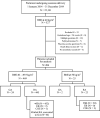Comparison of perioperative outcomes and anesthetic-related complications of morbidly obese and super-obese parturients delivering by cesarean section
- PMID: 36947155
- PMCID: PMC10035943
- DOI: 10.1080/07853890.2023.2187877
Comparison of perioperative outcomes and anesthetic-related complications of morbidly obese and super-obese parturients delivering by cesarean section
Abstract
Objective: To compare the perioperative outcomes and anesthetic-related complications of morbidly obese and super-obese parturients delivering by cesarean section.
Methods: A retrospective analysis of 6 years of data was performed. Exclusions were cases with gestational ages <24 weeks, placenta accreta spectrum, polyhydramnios, or multiple gestations.
Results: The study included 494 patients whose body mass index (BMI) exceeded 40 kg/m2 at delivery. Of these, 469 were morbidly obese (BMI 40-49.9; mean, 42.9 ± 2.4), and 25 were super obese (BMI >50; mean, 54.5 ± 4.2). Twenty-four (5.1%) morbidly obese women received general anesthesia. The other 445 patients (94.9%) in the morbid obesity group underwent cesarean delivery under regional anesthesia; however, some (2.2%; 10/445) received general anesthesia after regional anesthesia failed. In the super-obesity group, 23 patients (92.0%) received regional anesthesia, while two patients (8.0%) received general anesthesia. There were no cases of pulmonary aspiration, maternal deaths, or difficult or failed intubation. There was one episode of cardiac arrest in a patient with a BMI of 47.9. Among the morbidly obese and super-obese women given regional anesthesia, the super-obese patients had significantly greater volumes of ephedrine and norepinephrine consumption (p = 0.027 and 0.030), intravenous fluids (p = 0.006), and bleeding during surgery (p = 0.017). They also had more hypotensive episodes (p = 0.038). The two groups' incidences of neonatal birth asphyxia, postpartum hemorrhage, blood transfusion, and uterine atony did not differ significantly. The lengths of stay in the hospital were also comparable.
Conclusions: Among the women receiving regional anesthesia, the super-obese parturients had greater intraoperative bleeding, a higher proportion of hypotensive episodes, and a greater vasopressor requirement than the morbidly obese parturients. Anesthesiologists must prepare for the adverse perioperative events that such women risk experiencing during a delivery by cesarean section.
www.clinicaltrials.gov ID: NCT04657692.
Keywords: Anesthesia; cesarean delivery; complications; morbid obesity; perioperative outcomes; super obesity.
Plain language summary
Super obesity parturients are at a significantly higher risk of intraoperative bleeding, maternal hypotension, and higher vasopressor requirement compared to parturients with morbid obesity undergoing cesarean delivery.We additionally found a weak positive correlation between patient body weight and intraoperative blood loss in a patient with morbid obesity regardless of anesthetic technique.
Conflict of interest statement
No potential conflict of interest was reported by the author(s).
Figures



References
-
- Ward ZJ, Bleich SN, Cradock AL, et al. . Projected U.S. state-level prevalence of adult obesity and severe obesity. N Engl J Med. 2019;381(25):2440–2450. - PubMed
-
- Hales CM, Carroll MD, Fryar CD, et al. . Prevalence of obesity and severe obesity among adults: United States, 2017–2018. NCHS Data Brief. 2020;(360):1–8. - PubMed
-
- Heymsfield SB, Wadden TA.. Wadden TA: mechanisms, pathophysiology, and management of obesity. N Engl J Med. 2017;376(3):254–266. - PubMed
Publication types
MeSH terms
Substances
Associated data
LinkOut - more resources
Full Text Sources
Medical
